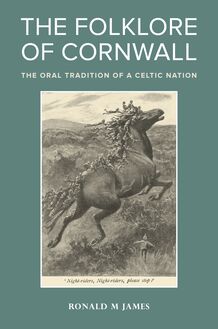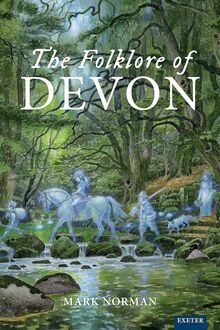The Boggart , livre ebook
183
pages
English
Ebooks
2022
Vous pourrez modifier la taille du texte de cet ouvrage
Obtenez un accès à la bibliothèque pour le consulter en ligne En savoir plus
Découvre YouScribe et accède à tout notre catalogue !
Découvre YouScribe et accède à tout notre catalogue !
183
pages
English
Ebooks
2022
Vous pourrez modifier la taille du texte de cet ouvrage
Obtenez un accès à la bibliothèque pour le consulter en ligne En savoir plus
Publié par
Date de parution
01 mars 2022
Nombre de lectures
5
EAN13
9781905816910
Langue
English
Poids de l'ouvrage
4 Mo
Honourable mention for The American Folklore Society's Wayland D. Hand Prize for outstanding book combining historical and folkloristic methods and materials.
Runner up for The Folklore Society's 2022 Katherine Briggs Award for most distinguished contribution to folklore studies.
The little-studied and once much-feared boggart is a supernatural being from the north of England. Against the odds it survives today, both in place-names and in fantasy literature—not least the Harry Potter universe. This book pioneers two methods for collecting boggart folklore: first, the use of hundreds of thousands of words on the boggart from newly digitized ephemera; second, about 1,100 contemporary boggart memories from social media surveys and personal interviews relating to the interwar and postwar years.
Combining this new data with an interdisciplinary approach involving dialectology, folklore, Victorian history, supernatural history, oral history, place-name studies and sociology, it is possible to reconstruct boggart beliefs, experiences and tales. The boggart was not, as we have been led to believe, a ‘goblin’. Rather, ‘boggart’ was a much more general term encompassing all solitary supernatural beings, from killer mermaids to headless phantoms, from black dogs to shape-changing ghouls.
The author shows how in the same period that such beliefs were dying out, folklorists continually misrepresented the boggart, and explores how the modern fantasy boggart was born of these misrepresentations. As well as offering a fresh reading of associated traditions, The Boggart demonstrates some of the ways in which recent advances in digitization can offer rich rewards.
Abbreviations
Illustrations and Maps
Acknowledgements
Preface
Part I: Situating the Boggart
1. Boggart Definitions and Sources
2. Boggart Origins
3. Boggart Distribution
Part II: Lived Boggart Folklore
4. Boggart Landscapes
5. Boggart Beliefs and Transmission
6. Social Boggarts
Part III: The Death and Rebirth of the Boggart
7. Boggart Death
8. The New Boggart
Conclusion
Appendix: Boggart A–Z
Bibliography
Index
Publié par
Date de parution
01 mars 2022
EAN13
9781905816910
Langue
English
Poids de l'ouvrage
4 Mo
The Boggart
A free, open access companion volume, The Boggart Sourcebook: Texts and Memories for the Study of the British Supernatural , curated and edited by Simon Young is also available from University of Exeter Press:
https://doi.org/10.47788/QXUA4856
In three corpora, it contains the raw materials that have informed the writing of The Boggart .
Exeter New Approaches to Legend, Folklore and Popular Belief
Series Editors: Simon Young , University of Virginia (CET, Siena) and Davide Ermacora , University of Turin
Exeter New Approaches to Legend, Folklore and Popular Belief provides a venue for growing scholarly interest in folklore narratives, supernatural belief systems and the communities that sustain them. Global in scope, the series encompasses milieus ranging from ancient to contemporary times and encourages empirically grounded, source-rich studies. The editors favour the broad multidisciplinary approach that has characterized the study of folklore and the supernatural, and which brings together insights from historians, folklorists, anthropologists and many other branches of the humanities and social sciences.
The Boggart
Folklore, History, Place-names and Dialect
SIMON YOUNG
First published in 2022 by
University of Exeter Press
Reed Hall, Streatham Drive
Exeter EX4 4QR, UK
www.exeterpress.co.uk
Copyright © Simon Young 2022
The author has asserted their rights under the Copyright, Designs and Patents Act 1988 to be identified as the author of this work.
A CIP catalogue record for this book is available from the British Library.
ISBN: 978-1-905816-90-3 (Hbk)
ISBN: 978-1-905816-91-0 (ePub)
ISBN: 978-1-905816-92-7 (PDF)
https://doi.org/10.47788/KZLH9484
Front cover: a boggart throws its head after an escaping pedestrian (Bowker, Goblin Tales , 136).
‘Boggarts!’ the antiquary sneer’t. ‘… When shall we hear the end of these foolish superstitions?’
‘When fancy’s dyead, an’ imagination buried undher t’ brass yeps we keepen pilin up o through England … Th’ end o’ superstition ’ll be th’ beginnin o’ summat a dyel wur.’
John Trafford Clegg, Works
Contents
Abbreviations
Illustrations and Maps
Acknowledgements
Preface
Part I: Situating the Boggart
1. Boggart Definitions and Sources
2. Boggart Origins
3. Boggart Distribution
Part II: Lived Boggart Folklore
4. Boggart Landscapes
5. Boggart Beliefs and Transmission
6. Social Boggarts
Part III: The Death and Rebirth of the Boggart
7. Boggart Death
8. The New Boggart
Conclusion
Appendix: Boggart A–Z
Bibliography
Index
Abbreviations
BC: Boggart Census (online PDF, see Preface)
BN: Boggart Names (online PDF, see Preface)
Ch: Cheshire
De: Derbyshire
ERY: East Riding of Yorkshire
La: Lancashire
Li: Lincolnshire
OCR: Optical character recognition
OED: Oxford English Dictionary
OSK: Six-inch Ordnance Survey Map of Kent
OSLa: Six-inch Ordnance Survey Map of Lancashire
OSMi: Six-inch Ordnance Survey Map of Middlesex
OSSur: Six-inch Ordnance Survey Map of Surrey
OSWe: Six-inch Ordnance Survey Map of Westmorland
OSY: Six-inch Ordnance Survey Map of Yorkshire
WRY: West Riding of Yorkshire
Illustrations and Maps
Frontispiece: Nineteenth-Century Boggartdom
Figure 1: ‘The Pillion Lady’ (Bowker, Goblin Tales , 79)
Figure 2: Supernatural Folk Taxonomy for Boggartdom
Figure 3: John Roby (Roby, Remains , frontispiece)
Figure 4: ‘One said it was a boggart, an another he said “Nay; It’s just a ge’man-farmer. that has gone an’ lost his way”’ (Caldecott, Three Jovial Huntsmen , 5–6)
Figure 5: First occurrence of Boggart in English, Coverdale Bible , folio 54
Figure 6: Early Boggart Authors, 1500–1700
Figure 7: Boggart Authors, 1700–1800
Figure 8: Distribution of Boggart Place-names
Figure 9: Occurrence of Boggart Personal Names
Figure 10: Boggarts in Wright
Figure 11: Northern Child Scarers after The Linguistic Atlas of England (Orton et al ., Atlas , L64)
Figure 12: Boggartdom, Boggledom and Dobbiedom
Figure 13: The Borders of Dobbiedom and Boggartdom
Figure 14: Nineteenth-century Worsthorne
Figure 15: John Higson, ‘from Photograph by C.A. Jackson[,] Oldham: John Higson historian of Gorton, Droylsden etc.’ (frontispiece in Crofton, A History of Newton Chapelry in the Ancient Parish of Manchester , I)
Figure 16: Supernatural Lees
Figure 17: Supernatural Droylsden
Figure 18: Supernatural Gorton
Figure 19: A boggart throws its head after an escaping pedestrian (Bowker, Goblin Tales , 136)
Figure 20: Nineteenth-century postcard of Hipperholme’s Boggart Lane
Figure 21: Boggart Holes, Boggart Caves and Boggart Cloughs
Figure 22: Ribchester Boggart Hole
Figure 23: Fence Boggard Hole
Figure 24: Supernatural Toponyms
Figure 25: ‘An Old Chimney Corner in Chadderton Fold’ (Waugh, The Chimney Corner , frontispiece)
Figure 26: ‘Lines on Green Lane Boggert’
Figure 27: Frank Ormerod, The Cock Hall Boggart
Figure 28: The Garstang Boggart transformed into the Garstang Ghost in the Illustrated Police News
Figure 29: Fake Ghost Hunt in Devon, Police News (29 September 1894), 1
Figure 30: ‘Bogart’ captured in Cumbria, 1988. Thanks to John Duff for permission to use this photograph by his father Brian Duff.
Figure 31: A Boggart from the Spiderwick universe
Figure 32: Esholt Boggard House in the late 1840s (OSY 202, 1851)
Figure 33: Boggart Memories in 2019
Figure 34: Boggart Personal Names in 2019
Figure 35: Main Entrance, Boggart Hole Clough (Blackley, Manchester), Edwardian postcard
Figure 36: Boggart Hole Clough in the 2019 Boggart Census
Figure 37: Treacle Miners and Clegg Hall Boggart in the 2019 Boggart Census
Figure 38: Treacle Mine Boggart
Figure 39: A Boggart (pre-installation) for the Pendle Sculpture Trail
Figure 40: Thomas Crofton Croker, the most influential of all boggart authors. Welsh Portrait Collection at the National Library of Wales
Figure 41: Croker’s Boggart (Roby, Traditions , II, 295, 1829)
Figure 42: ‘The Pertinacious Cobold’ in England and Wales
Figure 43: The Departure (Pyle, Pepper & Salt; or, Seasoning for Young Folk , 71)
Figure 44: The Boggart in Roberts ( Legends , 91)
Figure 45: The Brownie, or the good Boggart (Ewing, The Brownies , frontispiece)
Acknowledgements
In two cases, passages in this book have been published before. About two thirds of Chapter 2 appeared in the Transactions of the Yorkshire Dialect Society , 2018: the principal map shown there and some of the findings have been revised for this volume. About half of the ‘Boggart A–Z’ (the Appendix) appeared in Folk Life in 2018. I am extremely grateful to the editors of these two journals for permission to republish, not least as relatively little time has passed since the articles in question first came out. I am also grateful to Forteana Exchange, the Lancashire Place Name Survey, Helmshore History Society, Minorvictorianwriters.org.uk, and the Talking Folklore group for many different references. A number of editors and writers helped me with the Boggart Census. I would like to thank David Sutton at Fortean Times , Dee Dee Chainey and Willow Winsham at Folklore Thursday , and journalists on the Huddersfield Examiner , the Lancashire Post , the Lancashire Telegraph , the Manchester Evening News , and the Saddleworth Independent . It goes without saying that my greatest debt here is to the 1,100 people, mostly from the Northwest, who sent boggart emails, boggart letters, boggart Facebook comments, or who allowed themselves to be interviewed by a complete stranger.
I have relied on a large network of colleagues, academic and otherwise, who have helped me by obtaining scans and by advising me on individual points. These include Joan Beal, Valentina Bettin, Francesca Bihet, John Billingsley, David Britain, Paul Cavill, David Clarke, Alan Cleaver, Mike Dash, Gerry Desmond (Cork Library), John Duff, Holly Elsdon, Richard Green, David Hawkins, Katja Hrobat, Richard G. Jefferson, Richard Green, Peter Harding, David Haslam, David Hawkins, Ceri Houlbrook, Melanie James, Najla Kay (map-maker), Michael Kennedy, Roberto Labanti, Katherine Langrish, Nigel Massen, Silvia Meggiolaro, Alan McEwen, Stephen Miller, Lee Nicholson, Zach Nowak, Niall O’ Donnell, Caroline Oates, Georgina Ormrod, Cristina Paravano, David Pattern, Sofia Adele Frances Polcri, Louise Sylvester, Ray Sutcliffe, Roy Vickery, Steven Waterhouse, Carol Yoon, Emily Young (relation), Lea Young (relation), and Francis Young (no relation). I am especially in the debt of Simon Baker, Davide Ermacora, Lucy Evans, Jeremy Harte, Jessica Hemming, Ron James, Lynda Taylor, John Widdowson, and Chris Woodyard who commented on earlier drafts of this book; in some cases, several earlier drafts … I am much obliged, too, to my father, who introduced me to boggarts by taking my brother and me to the Boggart Stones at Widdop in around 1980 (and failing to tell us what a boggart was!) and who has sent, in the last years, scores of boggart volumes to me in Italy. I dedicate this book to my eldest daughter, Lisi, ‘the midnight boggart’, one of the sunlit joys of my life.
Preface
In this book I attempt to recreate the boggart-lore of Victorian and Edwardian times. What was a boggart ( Chapter 1 )? When and why did the word ‘boggart’ start to be used ( Chapter 2 )? In what parts of Britain did boggart beliefs feature in the 1800s ( Chapter 3 )? Where were boggarts to be found in the landscape ( Chapter 4 )? How were boggart tales passed on ( Chapter 5 )? How did nineteenth- and early twentieth-century communities react to boggart hauntings ( Chapter 6 )? How did boggart beliefs die away ( Chapter 7 )? And how have folklorists and fiction writers misreported popular beliefs about boggarts ( Chapter 8 )? The chapters are clearly about local and regional themes but the questions behind them are found much more widely. Here, after all, are matters of etymology, of distribution, of classification, of imagination and t






